Walking is an energy-efficient and non-polluting transportation mode as well as a key part of an active lifestyle, playing an important role in our society, environment, and health[1-2]. Walking can help alleviate traffic congestion and create more opportunities for residents to communicate with others, and it aids in increasing residents’ sense of community[3-4]. A compact and convenient community has high walkability and provides a variety of amenities, and amenities are distributed within a reasonable walking distance[5-6]. A community with high walkability encourages more people to walk for short trips[7-8]. Therefore, walkability has become an important foundation of community development and improving neighborhood walkability. As a kind of spatial property, walkability describes the guidance capacity of the space during the walking trips[9]. Specifically, it means not only the spatial closeness between the origin and destination but also walking convenience and comfort. Walkability is mainly affected by three factors. The first factor is the type of destination and its spatial layout[10]. The second factor is walking distance[11]. Only when the walking distance is acceptable, do people walk to the destination. The final factor is the pedestrian environment, which includes the density of the street, organizations at intersections, and road landscape[6].
Earlier studies on walkability concentrated on the pedestrian level of service (PLOS) assessed in terms of both walking facilities and traffic environments. HCM proposed a PLOS method based on pedestrian flow characteristics[12]. Considering the facility design and traffic flow condition along sidewalk, Dixon[13] put forward the Gainesville method which paid attention to not only pedestrian facility provided but also conflicts, motor vehicle LOS and so on. From the point of pedestrian perception, the trip quality method was proposed by Jaskiewicz et al.[14], and it is a qualitative evaluation from the pedestrians’ perspective of safety, comfort, and pleasantness.
With the gradually revealed vital role that the built environment played in walkability, studies on walkability extended to network-level evaluation. The following features affecting walkability were found: network design, sidewalk availability, building accessibility, residential density, land-use density and land-used diversity[9]. These factors were then applied in different combinations in the design of tools measuring the city walkability, such as BEH-NWI (built environment and health-neighborhood walkability index)[15], SWAT (Scottish walkability assessment tool)[16], WAT (walkability audit tool)[17], and WS (walk score)[18]. To better collect and quantify the impact factors, technologies such as geographic information systems (GIS)[3]and global positioning systems (GPS)[19] were also used to study walkability.
In the measurement of “walk score”, amenities’ weight values were decayed based on the walking distance decay law. Distance decay refers to the phenomenon of the decreasing probability of one amenity being selected along with the increase in walking distance[20-22]. This method used a decay coefficient to measure the degree of decay. The lower this value, the more seriously it decayed[23]. A considerable amount of research has been carried out to examine the distance decay law. Goel[24] reported the attenuation rule of commuting distance under different travel modes. Xia et al.[25] studied distance decay function among various amenities and then calculated the road path distance after decay from the residence to amenities. He et al.[26] found a spatial decay effect in walking access distance to metro stations, the decay rate of which, however, varies across stations. Jia et al.[27] delineated hospital service areas by using a Huff-based model which takes into account the decay effect of walking distance.
However, the above mentioned research assumed that the same walking distance decay law can be applied to all kinds of amenities, so they used the same decay coefficient for all amenities within the same walking distance. In China, the number of amenities is large and the type of amenities is plentiful within a community. Chinese cities are densely populated, and there is a wide gap between the rich and the poor.Therefore, residents’ selection preference varies according to factors such as their income and age, and different amenities are of interest to different groups. Taking the food service amenity as an example, a small eatery with simple equipment offers few dishes, so the attraction is limited. A food court consisting of several snack shops has a variety of dishes, so the attraction is greater. Large-scale restaurants with a variety of dishes, advanced facilities, and an elegant environment can even attract some residents from far away. It is obvious that the selection probability of the amenity is influenced not only by walking distance but also by the features of the amenity. Consequently, the same decay coefficient which was obtained from the same walking distance of different amenities in previous research cannot be applied in China.
1 Method
Based on the national conditions in China, this study first classified the amenities into 23 different categories. Then for each amenity category, the walking distance decay law of residents’ amenity selection, amenities’ acceptable walking distance, and optimum walking distance were determined, respectively.Finally, the binary logistic model was established among walking distance, amenity type, amenity scale and the probability of one amenity being selected. Results provide the decay coefficients of different amenities for measuring neighborhood walkability; they also provide references for the planning, site selection and evaluation of amenities.
1.1 Amenity classification
There are a wide variety of amenities in a community in China. Amenities of different types offer different services according to residents’ demand, and amenities of different scales have different diversity and substitutability according to residents’ preferences[28]. The type and scale of the amenity affect residents’ amenity selection[8,11], so we classified amenities according to their types and scales. By analyzing the number of different amenities in a block and the service content of different amenities, we determined the quantity, diversity, and substitutability for various amenities. Taking convenience stores as an example, the quantity is large because there are always more than three convenience stores for every square kilometer. The diversity is weak because every convenience store sells the same commodities. Thus, the substitutability of convenience stores is strong. This study analyzed the characteristics of all kinds of amenities and then determined the classification of them.
Referring to “Urban Community Planning and Design Criteria (GB 50180—1993)”[29]and the community survey, the amenities’ characteristics are presented in Tab.1, including service content, quantity, diversity, and substitutability.
Based on the characteristics of the amenities above, and comprehensively considering Chinese urban social-economic development conditions and the present situation of amenities in large communities in Beijing, amenities were classified into 9 categories: education, health care, food service, shopping, markets, parks, entertainment, finance, and post and telecommunications. Moreover, owing to a varying scale of amenities, they were divided into 23 types. The classification is detailed in Tab.2.
1.2 Survey sites
This paper surveyed the trip characteristics of residents to study the walking distance decay law for residents’ amenity selection. To guarantee that participants’ walking behaviors were based on the demands of daily residential life, the survey was conducted in large communities in Beijing. To ensure the universality and comprehensiveness of the survey, three different communities were chosen to carry out the survey, including Huilonguan community, Tiantongyuan community and Wangjing community, and their locations are shown in Fig.1. Huilongguan community is located between the north fourth ring road and north fifth ring road in the Changping District. The area of the structure is 8 km2, and the population is 325 000. Tiantongyuan community, located to the east of Huilongguan community, is also located in the Changping District. It covers an area of 8 km2, and the area of structure is 6 km2. Huilongguan community is known as the largest community in Asia and the population is 400 000. Wangjing community is located in the northeast of Beijing in the Chaoyang District. It covers an area of 8 km2, and the population of permanent residents is 300 000. These three communities were selected as survey regions due to their common features: an extensive area, huge population, and abundance of amenities.
Tab.1 Amenity characteristics
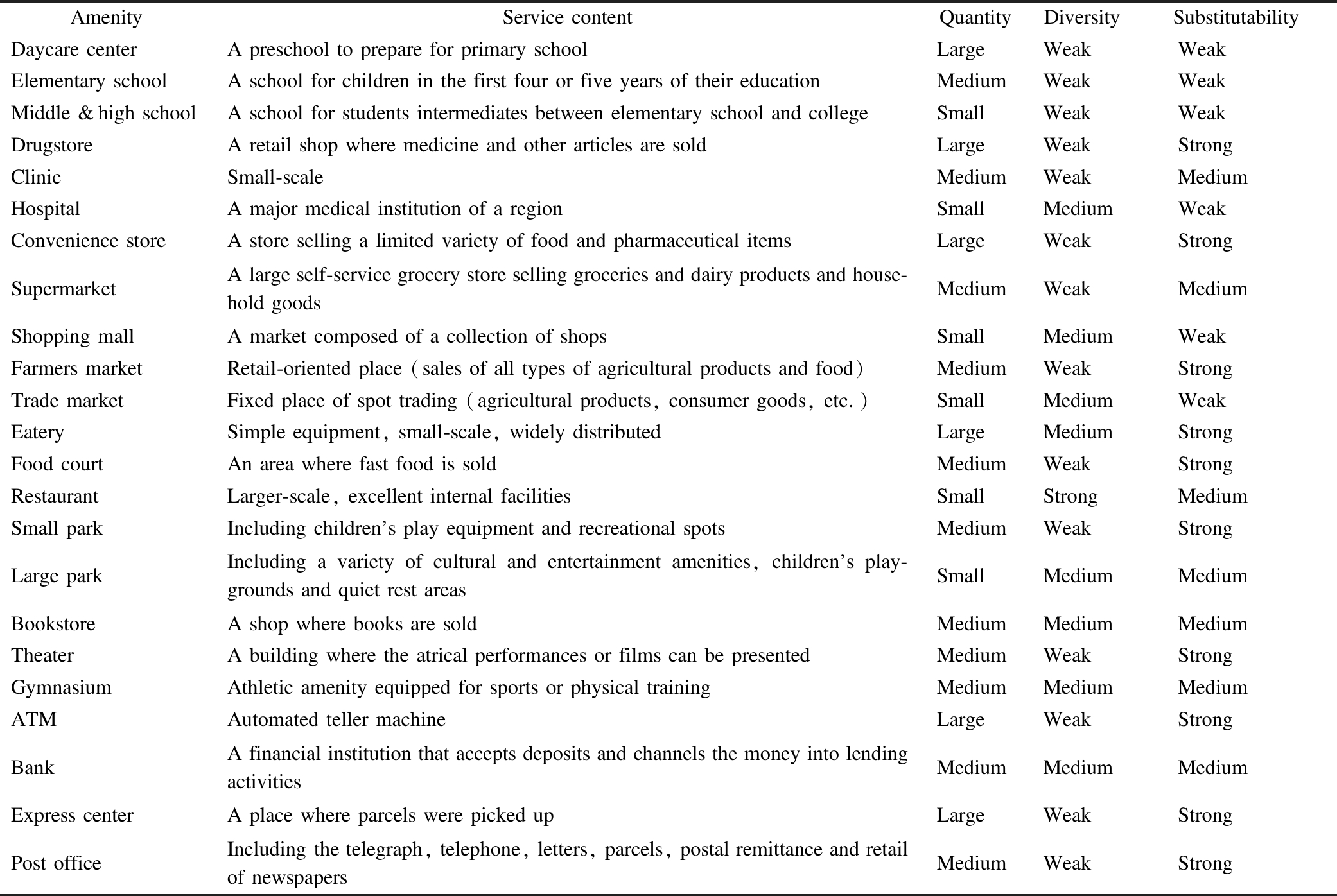
AmenityService contentQuantityDiversitySubstitutabilityDaycare centerA preschool to prepare for primary schoolLargeWeak WeakElementary schoolA school for children in the first four or five years of their educationMediumWeak WeakMiddle & high schoolA school for students intermediates between elementary school and collegeSmallWeak WeakDrugstoreA retail shop where medicine and other articles are soldLargeWeak StrongClinicSmall-scaleMediumWeak MediumHospitalA major medical institution of a regionSmallMedium WeakConvenience storeA store selling a limited variety of food and pharmaceutical itemsLargeWeak StrongSupermarketA large self-service grocery store selling groceries and dairy products and house-hold goodsMediumWeak MediumShopping mallA market composed of a collection of shopsSmallMedium WeakFarmers marketRetail-oriented place (sales of all types of agricultural products and food)MediumWeak StrongTrade marketFixed place of spot trading (agricultural products, consumer goods, etc.)SmallMedium WeakEaterySimple equipment, small-scale, widely distributedLargeMedium StrongFood courtAn area where fast food is soldMediumWeak StrongRestaurantLarger-scale, excellent internal facilitiesSmallStrong MediumSmall parkIncluding childrens play equipment and recreational spotsMediumWeak StrongLarge parkIncluding a variety of cultural and entertainment amenities, childrens play-grounds and quiet rest areasSmallMedium MediumBookstoreA shop where books are soldMediumMedium MediumTheaterA building where the atrical performances or films can be presentedMediumWeak StrongGymnasiumAthletic amenity equipped for sports or physical trainingMediumMedium MediumATMAutomated teller machineLargeWeak StrongBankA financial institution that accepts deposits and channels the money into lending activitiesMediumMedium MediumExpress centerA place where parcels were picked upLargeWeak StrongPost officeIncluding the telegraph, telephone, letters, parcels, postal remittance and retail of newspapersMediumWeak Strong
Tab.2 Amenity category

Amenity typeAmenity scale EducationDaycare centerElementary schoolMiddle & high school Health careDrugstoreClinicHospital Food serviceEateryFood courtRestaurant ShoppingConvenience storeSupermarketShopping mall MarketsFarmers marketTrade market ParksSmall parkLarge park EntertainmentBookstoreTheaterGymnasium FinanceATMBank Post and tele- communicationsExpress centerPost office
The surveyed amenities were selected in the above three communities, and only one amenity was chosen as the survey site for each kind of amenity in each community. Aiming at 23 kinds of amenities, this survey had a selected total of 69 amenities as survey sites, the locations of which are shown in Fig.2.
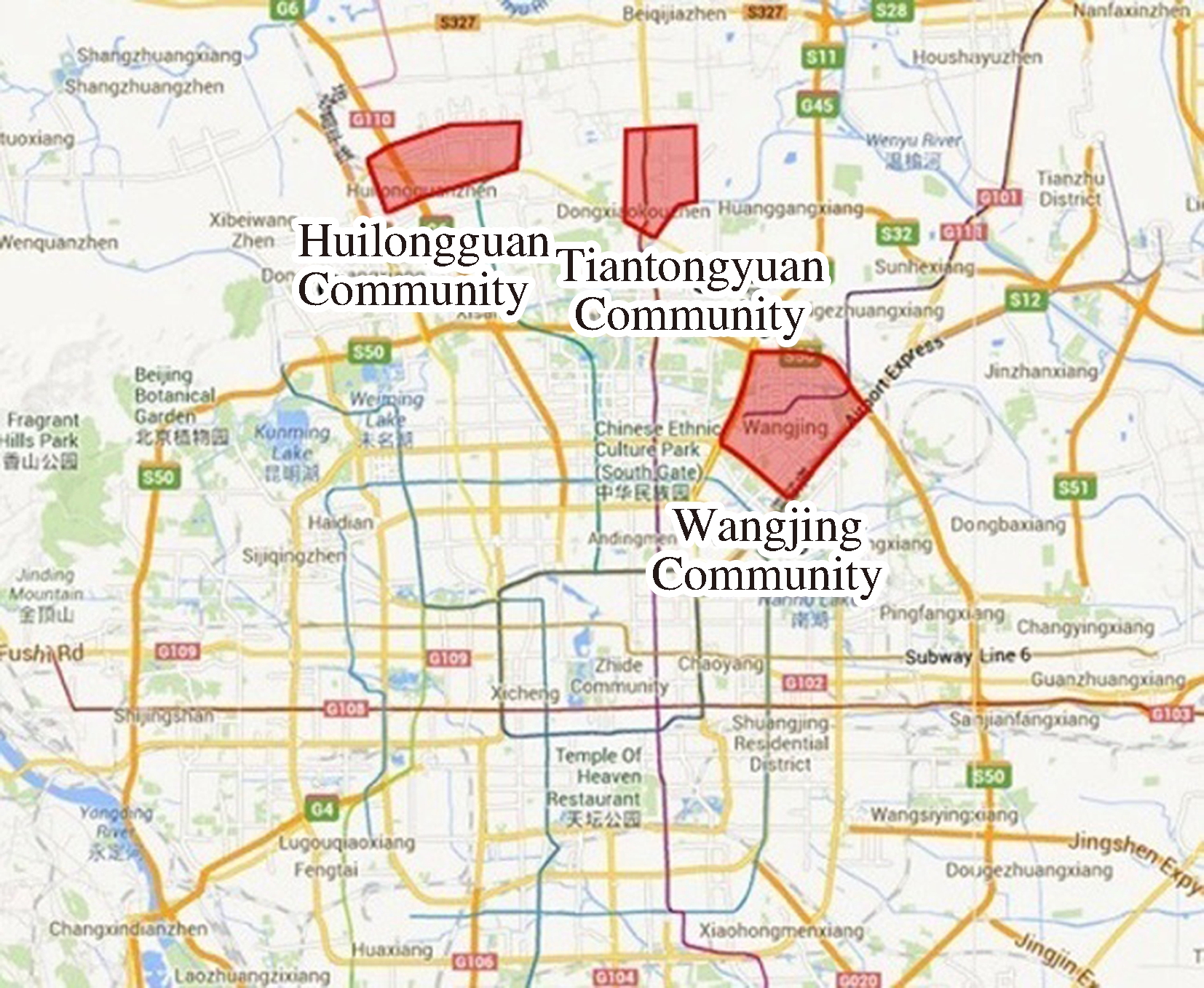
Fig.1 Location of three communities

(a)

(b)

(c)
Fig.2 Location of survey sites.(a) Huilongguan Community; (b) Tiantongyuan Community; (c) Wangjing Community
1.3 Questionnaire design
To reflect the actual trip characteristics, this survey was conducted as a field survey, and the interviewed residents were located inside the amenities.
The questionnaire included two aspects: demographic characteristics and trip characteristics. Questions relating to demographic characteristics included gender, age, and household car ownership. Questions relating to trip characteristics included the usage frequency of the amenity, trip mode (whether by foot or not), walking time and acceptable walking time. Usage frequency reflected the importance of the amenity. Trip mode helped to identify the residents who chose the amenity on foot. Using the standard walking speed of 1 m/s[30], walking time was converted into walking distance. Acceptable walking time represented the maximum distance that the residents could reasonably walk to the amenity. During the survey, residents walking to the amenity were asked their walking time for the trip; residents traveling by other transportation modes were asked their acceptable walking time for the amenity.
1.4 Demographic characteristics
The survey was carried out from 20 May to 26 May and from 3 June to 9 June 2013. A random distribution of 1 901 questionnaires yielded a return of 1 860 valid questionnaires. Respondents’ demographic characteristics are shown in Tab.3.
Statistics show that the proportions of males and females are about equal, and the respondents cover a wide range of ages. 39% of the respondents owned a car. Although residents can be affected by the ownership of cars, they prefer to walk to the amenities within a short distance.
Tab.3 Demographic characteristics of respondents
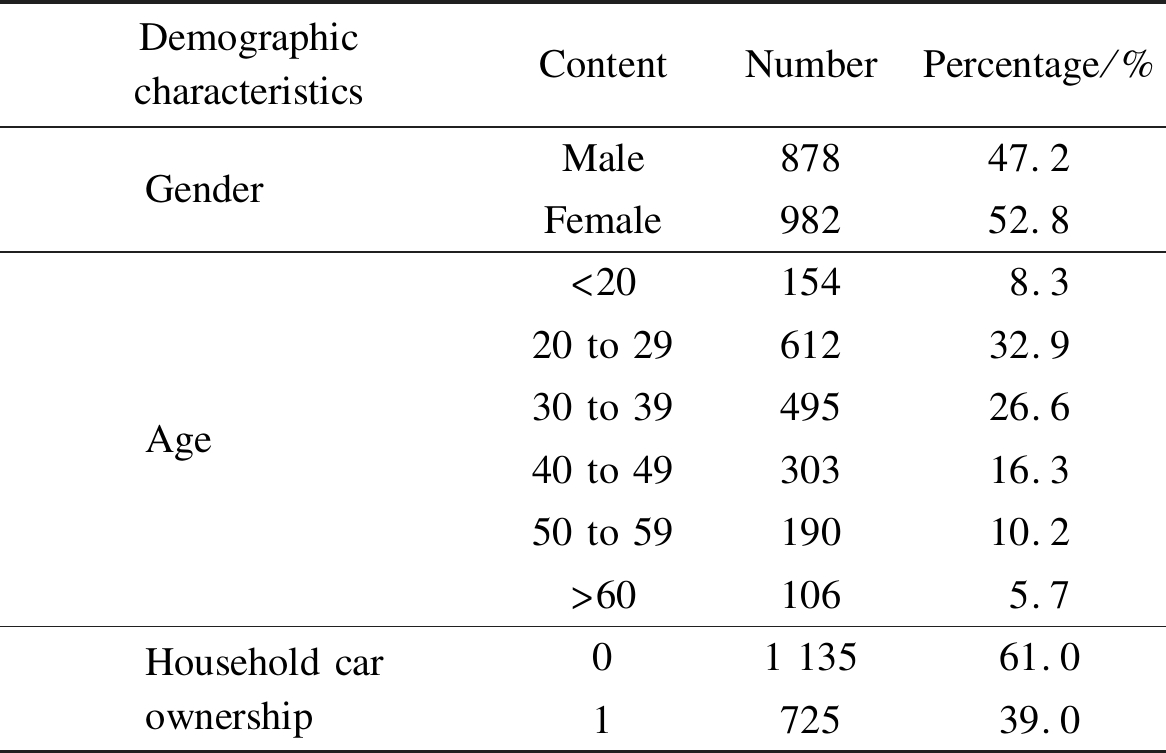
DemographiccharacteristicsContentNumberPercentage/%GenderMale87847.2 Female98252.8 Age<201548.320 to 2961232.930 to 3949526.640 to 4930316.350 to 5919010.2>601065.7Household carownership01 13561.0172539.0
2 Walking Distance Decay Law
To reflect the walking distance decay law,the distance decay graphs of residents’ amenity selection were drawn by two curves based on the data of walking distance. The section curve represents the percentage of pedestrians who reach the amenity at a given walking distance section; the accumulation curve represents the cumulative percentage of pedestrians who reach the amenity within a given walking distance, which is the percentage of pedestrians whose walking distance to the amenities is not greater than the given distance. As shown in Fig.3, in the section curve, given that the walking distance is 900 m, in the section curve, the percentage of pedestrians is 23%. It indicates that the number of pedestrians whose walking distance ranges from 600 to 900 m counts for 23% of all pedestrians, while in the accumulation curve, the cumulative percentage of pedestrians is 69%. This indicates that the number of pedestrians whose walking distance is not greater than 900 m accounts for 69% of all pedestrians.
Furthermore, this study analyzed the walking distance decay law from three aspects, including the selection conditions of all amenities, different types of amenities, and different scales of amenities.
2.1 All amenities
The data of all amenities’ walking distance was used to draw the distance decay graph to analyze the general situation that residents walked to the amenities.Fig.3 shows the walking distance delay curve of all amenities. The curve first has a descending tendency, which means that the number of pedestrians decreases with the increase in walking distance from the origin to the amenity. Secondly, when the walking distance is 300 m, the cumulative percentage of pedestrians is 100%. It means that the number of pedestrians does not decay for the amenity within 300 m[27]. Thirdly, after 300 m, the curve declines rapidly with the increase in the distance. After 1 500 m, it declines smoothly with greater distance. It shows that the decay speed of the number of pedestrians is rapid at first and then becomes slower. Finally, once the distance reaches 2 400 m, both percentages are at 2%. There are hardly any people traveling on foot.
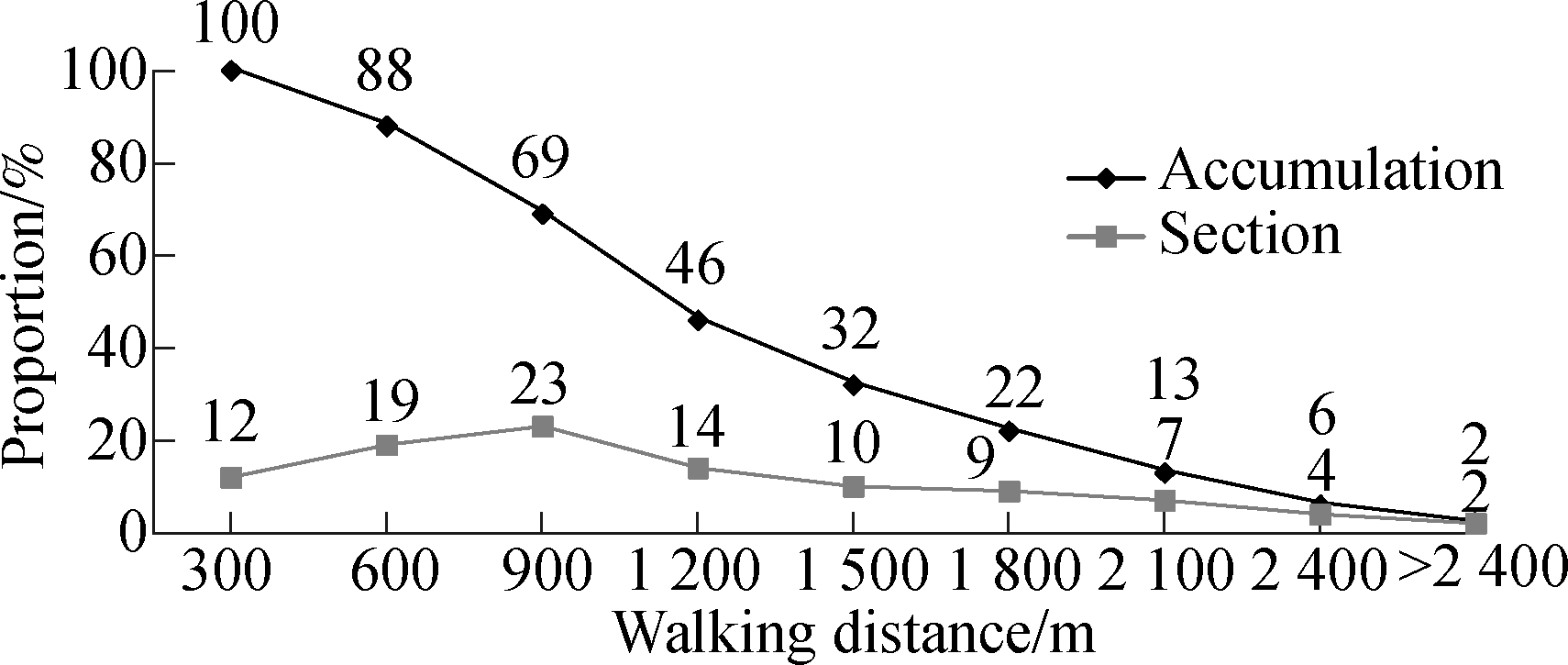
Fig.3 Distance decay graph of all amenities
In summary, the walking distance decay law is obvious, and the probability that a resident chooses the amenity by foot decays with the increase in walking distance.
2.2 Amenities of different types
To explore the walking distance decay laws of different types of amenities, the distance decay graphs of 9 categories of amenities were drawn. For example,Fig.4 shows the distance decay graphs of health care amenities and food service amenities. Comparing the two-section curves, when the walking distance is 900 m, the percentage of pedestrians is the greatest for the health care amenity. This means that most pedestrians’ walking distance to health care amenities ranges from 600 to 900 m. Secondly, comparing the two accumulation curves, the curve for health care amenities declines more rapidly within 1 200 m. The cumulative percentage is 34% for health care amenities, while it is 57% for food service amenities. This means that the decay speed of the number of pedestrians is faster for health care amenities. Thirdly, when
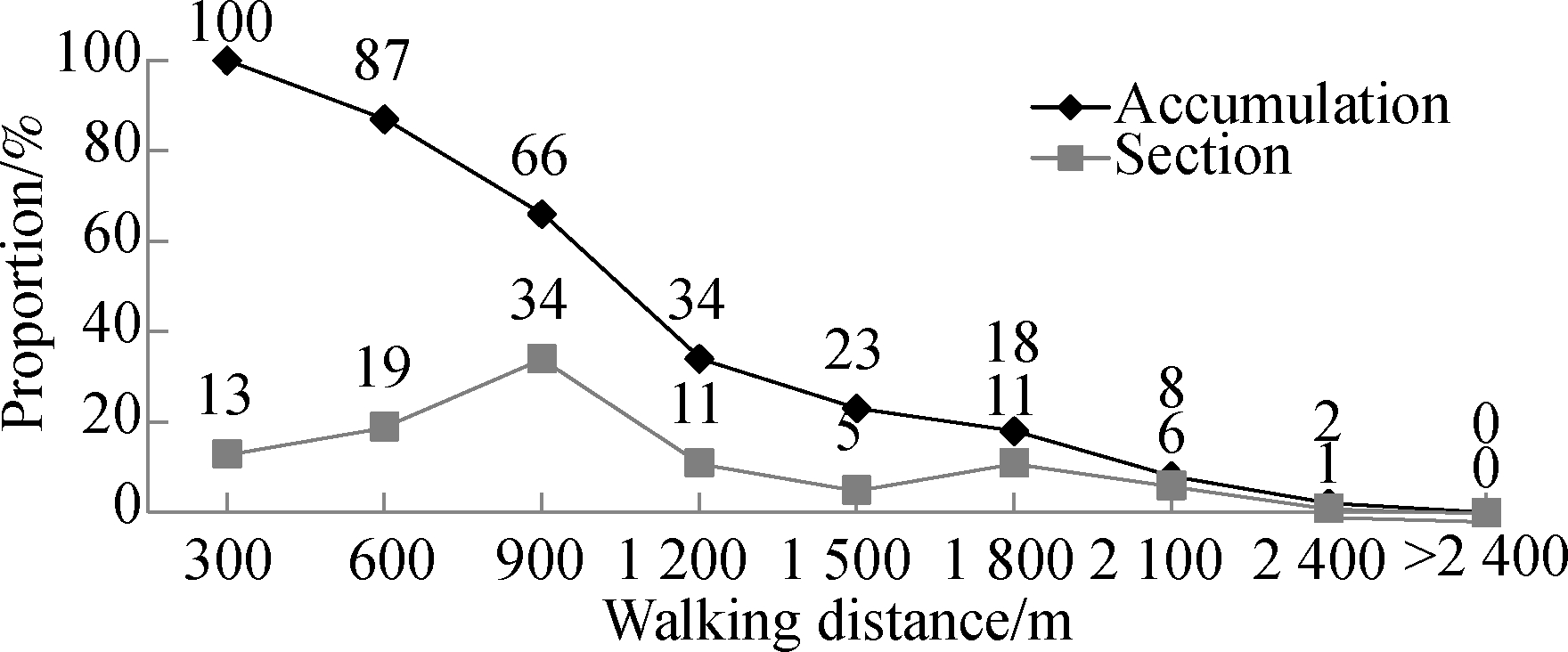
(a)
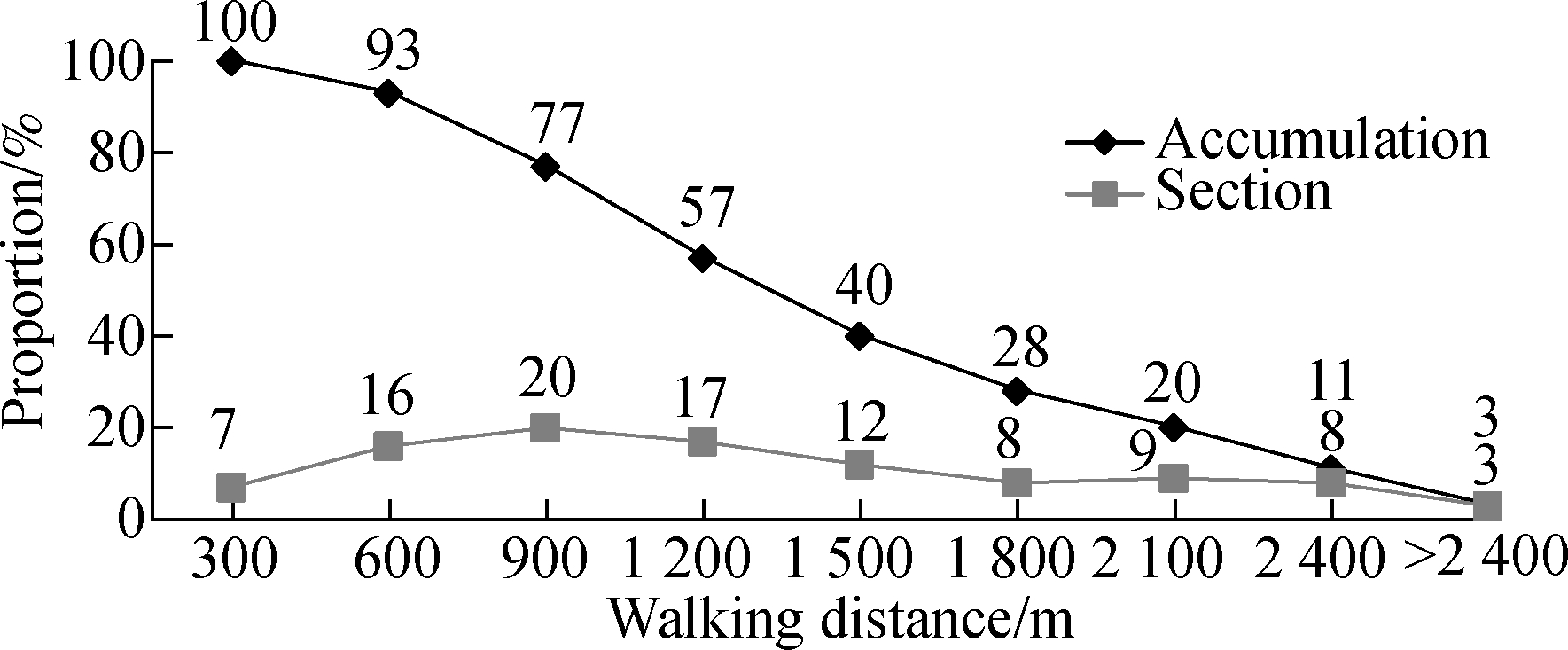
(b)
Fig.4 Distance decay graphs of different types of amenities.(a) Health care amenity; (b) Food service amenity
the walking distance is 2 400 m, the percentage is 2% for health care amenities while it is 11% for food service amenities. This indicates that residents are willing to walk a longer distance to food service amenities.
Through the analysis of the distance decay graphs of 9 categories of amenities, it can be concluded that: different types of amenities have different distance decay laws; the decay speeds of amenities with high demand and weak substitutability are slower; residents can accept a longer walking distance for these amenities. For example, catering and shopping are more closely associated with residents’ daily lives, and food service amenities and shopping amenities are used more frequently. Their decay speeds are slower, and residents are willing to walk longer distances. However, education amenities and health care amenities have specific service populations and they hold less attraction. Therefore, their decay speeds are faster, and residents will not like walking long distances to these amenities. However, the daycare center which has a high demand and weak substitutability is special. The decay speed of the daycare center is fast, and the acceptable walking distance is short. One possible reason is that parents escorting kids in school trips care more about convenience and safety. They tend to go to the daycare centers by car for long distances.
2.3 Amenities of different scales
The distance decay graphs of different scales of amenities are displayed in Fig.5, which are represented by convenience stores, supermarkets, and shopping malls. First, comparing the section curves, the three curves all have obvious peaks, when the walking distance is 600 m for convenience stores, 1 500 m for supermarkets and 1 200 m for shopping malls. This indicates the walking distance that most pedestrians considered suitable. Secondly, comparing the accumulation curves, the curve for convenience shops drops more quickly. When the walking distance is 900 m, the cumulative percentage is 38%, while it is 81% for supermarkets and 91% for shopping malls. This means that the decay speed of the number of pedestrians is faster for convenience stores. Thirdly, when the walking distance reaches 2 400 m, the cumulative percentage is zero for convenience stores, while it is 5% for supermarkets and 8% for shopping malls. It indicates that the residents are willing to walk longer distances to supermarkets and shopping malls.
Through the analysis of distance decay graphs of 23 kinds of amenities, it can be concluded that: different scales of amenities have different distance decay laws; the decay speeds of larger-scale amenities were slower; the larger the scale of the amenity, the longer the walking distance that will be accepted by residents. Large-scale amenities such as restaurants and shopping malls hold greater attraction, and there is always at least one restaurant and one shopping mall in a community. Residents are willing to walk longer distances to these amenities, so their decay speeds are slow. However, small-scale amenities such as convenience stores and eateries are numerous and their substitutability is strong. Residents always choose another amenity if a particular one is far away from their origin, so their decay speeds are fast.
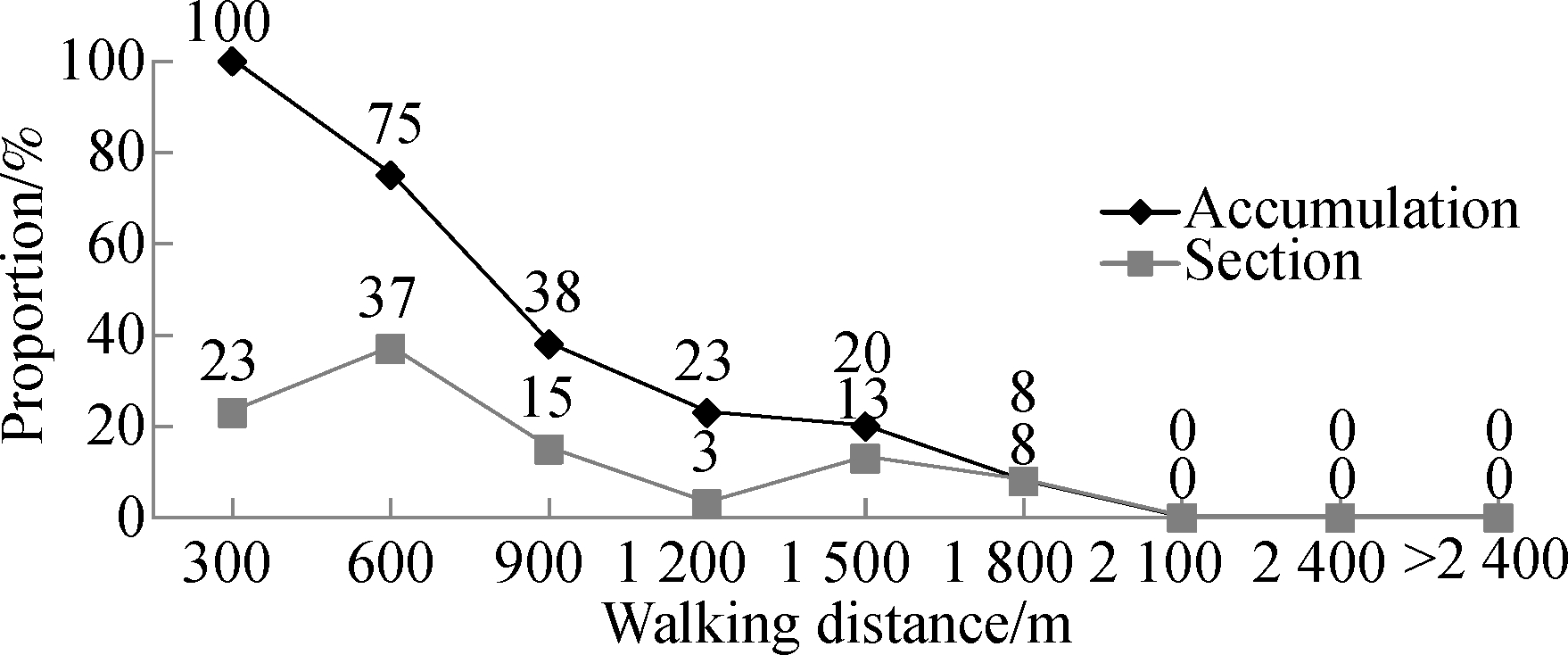
(a)

(b)
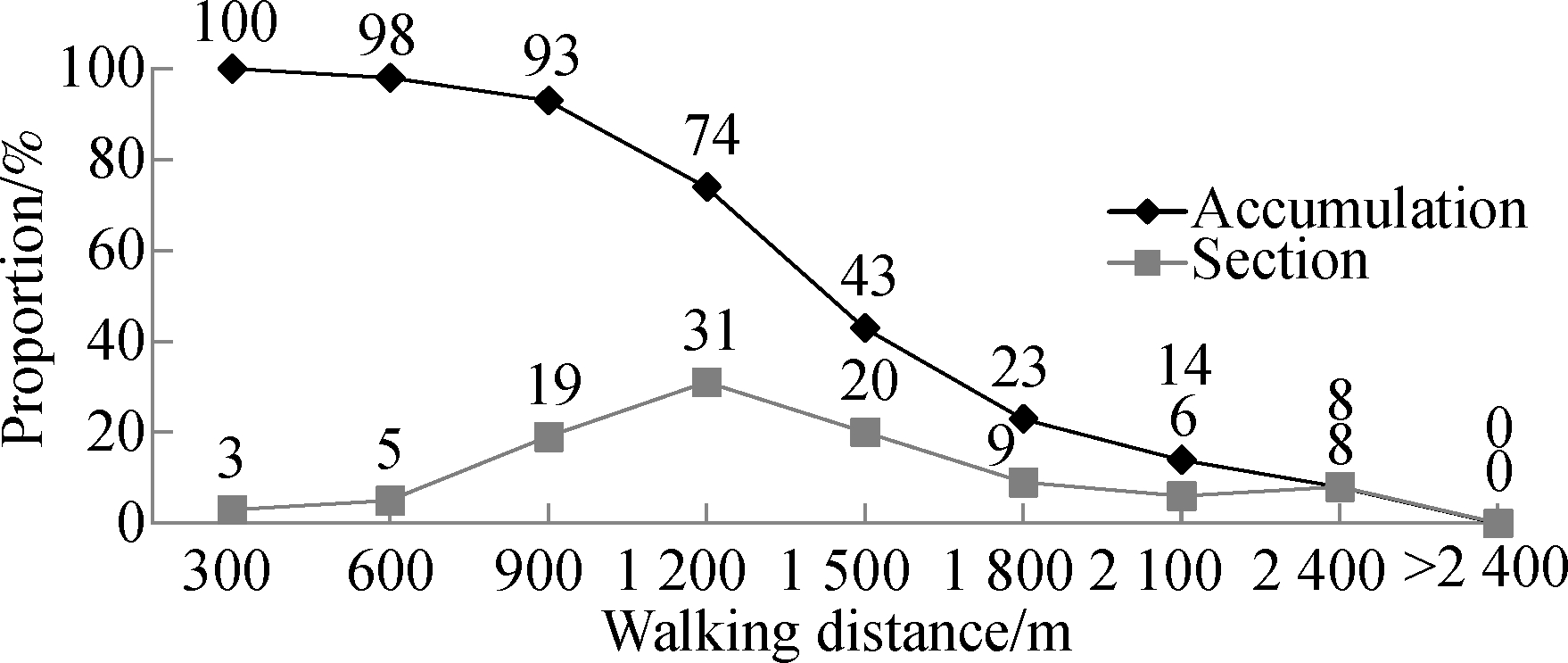
(c)
Fig.5 Distance decay graphs of different scales of amenities.(a) Convenience store; (b) Supermarket; (c) Shopping mall
2.4 Acceptable walking distance and optimum walking distance
According to previous research, when the percentage of pedestrians declined to 0%, that distance could be chosen as the acceptable walking distance;when the percentage of pedestrians reduced to 40%, that distance could be chosen as the optimum walking distance[31]. According to the survey data of all kinds of amenities, the acceptable walking distance and optimum walking distance were obtained. They are listed in Tab.4.
From Tab.4, it can be seen that the acceptable walking distances of all amenities range from 2 100 to 2 800 m, and the optimum walking distances range from 750 to 1 900 m. It indicates that most walking trips are not farther than 2 800 m, and residents are more willing to walk a distance no greater than 1 880 m. This result is roughly identical to the finding of Lu and Wang[23]. They found that most amenities’ acceptable walking distances were not more than 2 400 m in America, and the percentage of pedestrians reduced to 31% when the walking distance was 1 600 m. However, they did not consider that acceptable distances of different amenities may be different. Secondly, we find that the acceptable walking distance and the optimum walking distance are different for different types of amenities. Food service amenities and entertainment amenities have longer acceptable walking distances and optimum walking distances. However, health care amenities have shorter acceptable walking distances and optimum walking distances. The result is in line with prior evidence found by Jia and Jiang[32]. They considered that the accessibility standards of different amenities for walkable neighborhoods were different, but only five types of amenities were analyzed, including education, medical service, entertainment, shopping, and post & telecom. For example, their study showed that the optimum distance from the medical service to the dwelling building was 800 m, while the optimum distance from the theatre to the dwelling building was 2 000 m. Thirdly, we find that the acceptable walking distances and optimum walking distances are proportional to the scale of amenities. The acceptable walking distances of convenience stores, supermarkets, and shopping malls are 2 100, 2 500 and 2 800 m, respectively, and their optimum walking distances are 750, 1 550 and 1 650 m, respectively. A previous study by Yi[33] also proved that the attractive radius of different scales of amenities was different. Our results provide references for the planning, site selection and evaluation of amenities.
Tab.4 Acceptable walking distance and optimum walking distance
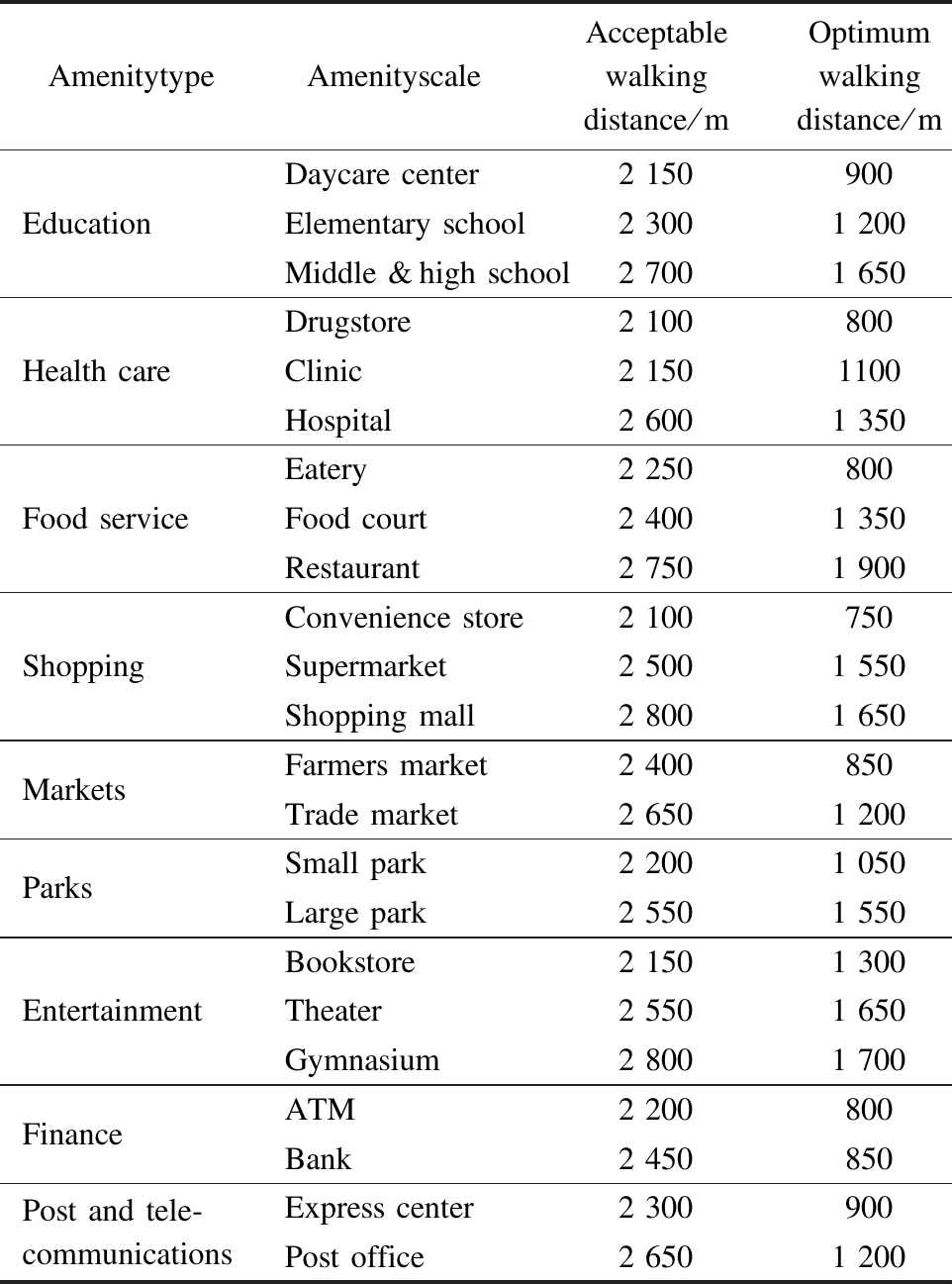
AmenitytypeAmenityscaleAcceptable walkingdistance/mOptimum walkingdistance/mEducationDaycare center2 150900Elementary school2 3001 200Middle & high school2 7001 650Health careDrugstore2 100800Clinic2 1501100Hospital2 6001 350Food serviceEatery2 250800Food court2 4001 350Restaurant2 7501 900ShoppingConvenience store2 100750Supermarket2 5001 550Shopping mall2 8001 650MarketsFarmers market2 400850Trade market2 6501 200ParksSmall park2 2001 050Large park2 5501 550EntertainmentBookstore2 1501 300Theater2 5501 650Gymnasium2 8001 700FinanceATM2 200800Bank2 450850Post and tele-communicationsExpress center2 300900Post office2 6501 200
3 Model Development
3.1 Modeling methods
In previous research, walking distance was considered as a major influencing factor for walkability. Amenities’ weights decay according to the walking distance, and the degree of decay is represented by the decay coefficient. The lower this value, the more significantly the weight decays. Based on the analysis described above, it can be found that the decay coefficient is affected not only by walking distance but also by the amenity type and scale. So, this study uses the probability that the amenity is chosen by residents on foot as a decay coefficient, comprehensively considering the effect of walking distance, amenity type, and amenity scale. The relationship between the probability and the three influencing factors are established using the binary logistic model, the basic form of which is
(1)
where P is the probability that a resident chooses to walk to the amenity; xi(i=1,2,…,m) is the influencing factor; x1 is the amenity type; x2 is the amenity scale; x3 isthe walking distance from the origin to the amenity; a,bi(i=1,2,…,m) are the estimated parameters.
The equivalent form of Eq. (1) is
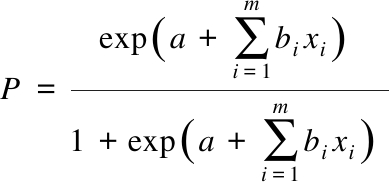
(2)
The distribution function above is a binary logistic distribution function. Based on the survey data, the parameters are estimated using an iterative maximum likelihood procedure with the statistical analysis software SPSS.
3.2 Establishment and validation of the model
Through the review of literature and the survey of amenities in Beijing, this model uses walking distance, amenity type, and amenity scale as the independent variables and uses whether or not a resident chooses to walk to the amenity as the dependent variable. If a resident chooses to walk to the amenity, the dependent variable is equal to 1. If a resident does not choose to walk to the amenity, the dependent variable is equal to 0. The analyses of the influencing factors and variables are shown in Tab.5.
All survey data was imported into SPSS to estimate the parameters of the model, and the results are shown in Tabs. 6 and 7.
Tab.5 Influencing factors and variables of the model
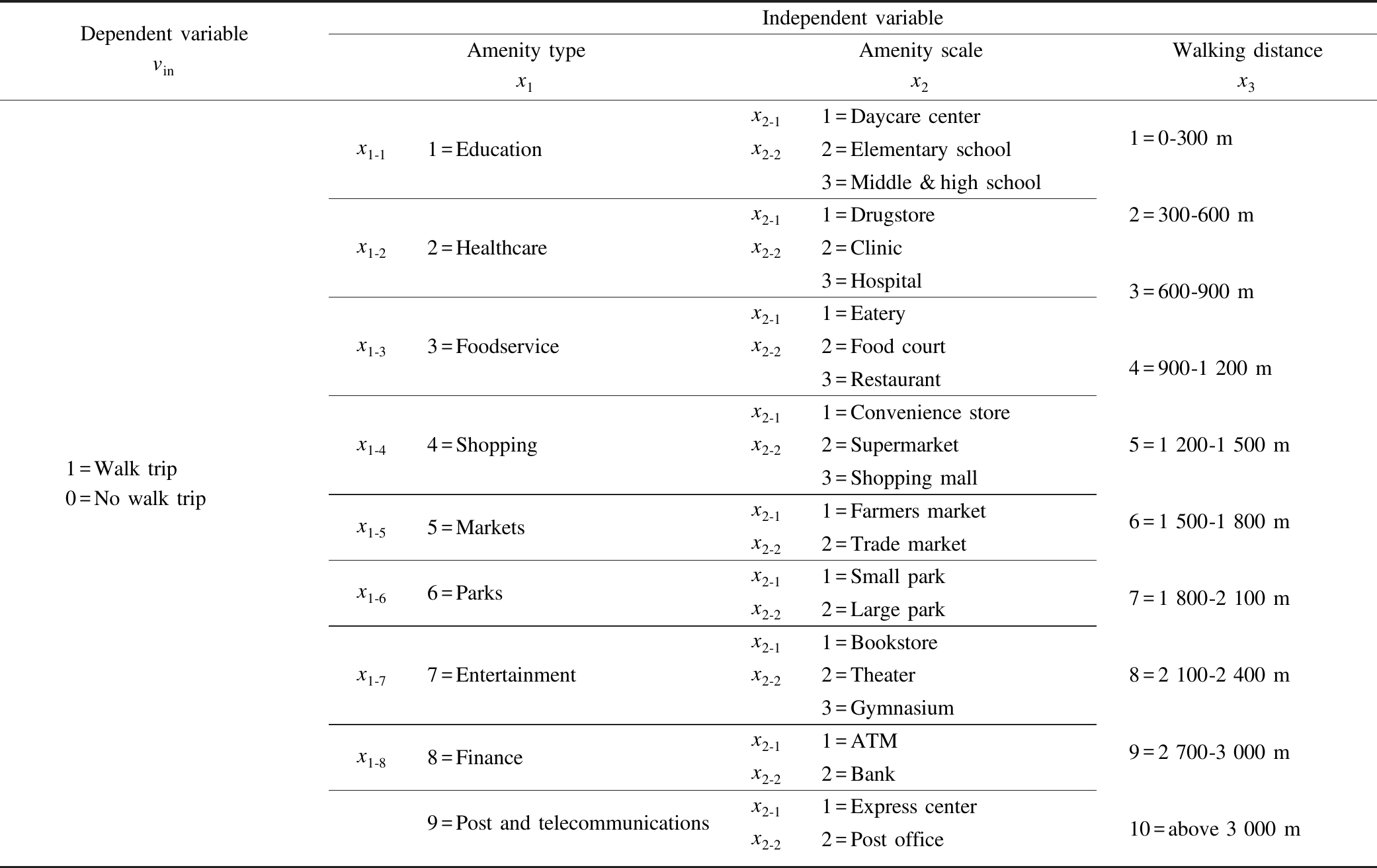
Dependent variablevinIndependent variableAmenity typex1Amenity scalex2Walking distancex31=Walk trip0=No walk tripx1-11=Educationx1-22=Healthcarex1-33=Foodservicex1-44=Shoppingx1-55=Marketsx1-66=Parksx1-77=Entertainmentx1-88=Finance9=Post and telecommunicationsx2-11=Daycare centerx2-22=Elementary school3=Middle & high schoolx2-11=Drugstorex2-22=Clinic3=Hospitalx2-11=Eateryx2-22=Food court3=Restaurantx2-11=Convenience storex2-22=Supermarket3=Shopping mallx2-11=Farmers marketx2-22=Trade marketx2-11=Small parkx2-22=Large parkx2-11=Bookstorex2-22=Theater3=Gymnasiumx2-11=ATMx2-22=Bankx2-11=Express centerx2-22=Post office1=0-300 m2=300-600 m3=600-900 m4=900-1 200 m5=1 200-1 500 m6=1 500-1 800 m7=1 800-2 100 m8=2 100-2 400 m9=2 700-3 000 m10=above 3 000 m
Tab.6 Statistics results of the model

CategoryStatistics resultsNumber of independent variables11Number of effective samples1 860Percentage correct80.4%-2 log likelihood1 645.339Cox & Snell R square0.381Nagelkerke R square0.512
Tab.7 Regression analysis results of the model

BS.E.WaldDfSig.Exp(B)Type23.56080.003Type-1-0.7800.3006.77910.0090.458Type-2-0.6640.2975.01910.0250.515Type-3-0.7320.2976.07510.0140.481Type-4-0.7010.2945.67410.0170.496Type-5-0.4490.3231.93910.1640.638Type-6-0.0650.3400.03710.8470.937Type-7-0.5530.2993.43110.0640.575Type-8-1.1710.29815.46510.0000.310Scale14.66420.001Scale-1-0.7150.18714.59110.0000.489Scale-2-0.5170.1798.32710.0040.596Distance-0.8500.040461.52210.0000.427Constant5.0630.372185.04810.000158.100Note:B represents regression coefficient; S.E. represents the standard error of regression coefficient; Wald represents the observations of Wald test statistics; Df represents the degree of freedom; Sig. repre-sents the P value of Wald test statistics.
Thus, the binary logistic probability can be expressed as model have statistical significance. From Tab.6, a total of 80.4% of the residents deciding whether or not to walk to the amenities are correctly predicted by the model. Two goodness-of-fit statistics, Cox & Snell R square and Negalkerke R square, are 0.381 and 0.512, respectively. The two pseudo R squares reflect from different perspectives that the independent variables in the current model explain the proportion of the variation of the dependent variables to the total variation of the dependent variables.The accuracy is high if these Pseudo R squares are between 0.2 and 0.4 in practice[34]. High degree of goodness-of-fit means that the model can effectively explain the walking distance decay law for residents’ amenity selection.
v1n=5.063-0.780x1-1-0.664x1-2-0.732x1-3-
0.701x1-4-0.449x1-5-0.065x1-6-0.553x1-7-
1.171x1-8-0.715x2-1-0.517x2-2-0.850x3
(3)
(4)
The calculated probability from the model reflects the probability that a resident chooses to walk to the amenity within the given distance. The model can be applied in general planning to identify the expected shifts in walking behavior associated with changes in the distributions of different amenities. The probability helps to set clear policy goals: A community aiming to increase the number of people walking maybe needs to prioritize amenities of different types and scales. The probability also can be used as the decay coefficient of the amenity in the measurement of walkability, and the decay coefficient is used to calculate the amenity’s weight value in different walking distances. We calculated the decay coefficients of different kinds of amenities when the walking distance was 500, 1 000, 1 500, and 2 000 m. The results are shown in Tab.8.
As shown in Tab.8, decay coefficients decrease with the increase in walking distance. It indicates that the longer the walking distance, the lower the probability that a resident chooses to walk to the amenity. Moreover, different kinds of amenities have different decay coefficients at the same distance, and the decay coefficient increases with the increase in the scale of amenities. Taking the example of food service amenities, when the walking distance is 1 000 m, the decay coefficient of an eatery is 0.376, while it is 0.580 for a food court and 0.781 for restaurant. The results are consistent with the distance decay laws analyzed above.
Tab.8 Decay coefficients at different walking distances
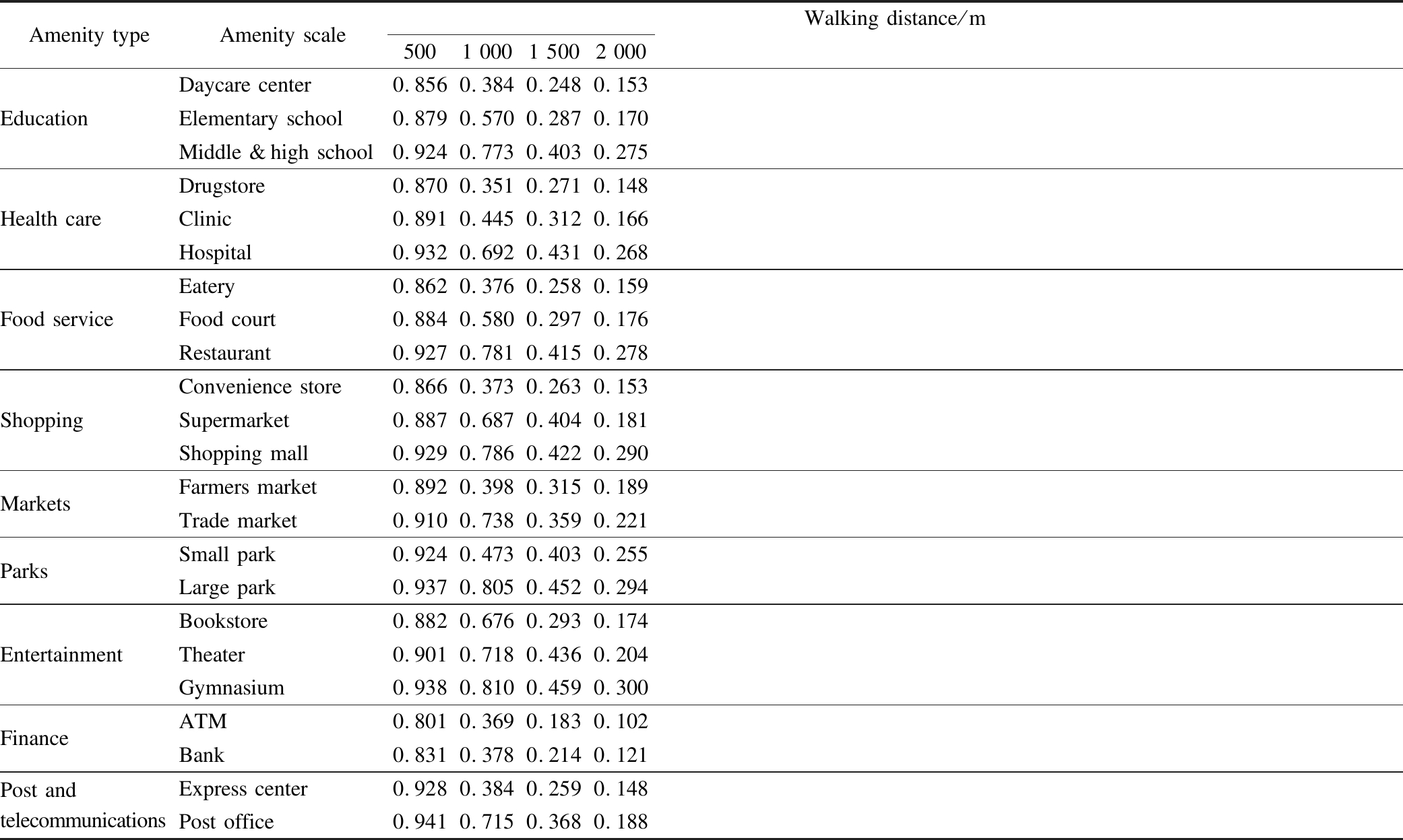
Amenity typeAmenity scaleWalking distance/m5001 0001 5002 000EducationDaycare center0.8560.3840.2480.153Elementary school0.8790.5700.2870.170Middle & high school0.9240.7730.4030.275Health careDrugstore0.8700.3510.2710.148Clinic0.8910.4450.3120.166Hospital0.9320.6920.4310.268Food serviceEatery0.8620.3760.2580.159Food court0.8840.5800.2970.176Restaurant0.9270.7810.4150.278ShoppingConvenience store0.8660.3730.2630.153Supermarket0.8870.6870.4040.181Shopping mall0.9290.7860.4220.290MarketsFarmers market0.8920.3980.3150.189Trade market0.9100.7380.3590.221ParksSmall park0.9240.4730.4030.255Large park0.9370.8050.4520.294EntertainmentBookstore0.8820.6760.2930.174Theater0.9010.7180.4360.204Gymnasium0.9380.8100.4590.300FinanceATM0.8010.3690.1830.102Bank0.8310.3780.2140.121Post and telecommunicationsExpress center0.9280.3840.2590.148Post office0.9410.7150.3680.188
4 Conclusions
1) The number of pedestrians who walk to the amenity decreases with the increase in walking distance from the origin to the amenity. Walking distance decay speeds are slower for amenities with a high demand and weak substitutability. Walking distance decay speeds of amenities with a larger scale are slower.
2) The acceptable walking distance and optimum walking distance are different for different types and scales of amenities. Amenities with higher attraction and a larger scale have a longer acceptable walking distance and optimum walking distance.
3) A binary logistic model was established for walking distance, amenity type, amenity scale and the condition of residents’ amenity selection. The decay coefficients of different amenities at different walking distances were obtained.
4) The results coincide more closely with the current situation of China and provide references for the site selection and evaluation of amenities, but there are still some limitations. Future study is needed to verify the validity of the self-reported data, especially for the resident’s estimation of walking distance. Walking speeds are different for different crowds and trips. Hence, future study will include variations in both speed and duration of the walk trips in order to improve the accuracy of walking distance. We also hope to recruit volunteers to record their walking tracks by handheld GPS. Furthermore, there is an urgent need for a complete set of measuring methods for neighborhood walkability that applies to China, and the decay coefficients of different amenities offered by this study can advance this research.
[1] Tabaei B P, Rundle A G, Wu W Y, et al. Associations of residential socioeconomic, food, and built environments with glycemic control in persons with diabetes in New York City from 2007—2013[J].American Journal of Epidemiology, 2018, 187(4): 736-745. DOI:10.1093/aje/kwx300.
[2]Sallis J F, Cerin E, Conway T L, et al. Physical activity in relation to urban environments in 14 cities worldwide: A cross-sectional study[J].The Lancet, 2016, 387(10034): 2207-2217. DOI:10.1016/S0140-6736(15)01284-2.
[3]Al Shammas T, Escobar F. Comfort and time-based walkability index design:A GIS-based proposal[J]. International Journal of Environmental Research and Public Health, 2019, 16: 2850-1-2850-22. DOI:10.3390/ijerph16162850.
[4]Sung H, Lee S. Residential built environment and walking activity: Empirical evidence of Jane Jacobs’ urban vitality[J].Transportation Research Part D: Transport and Environment, 2015, 41: 318-329. DOI:10.1016/j.trd.2015.09.009.
[5]Smart M J. Walkability, transit, and body mass index:A panel approach[J]. Journal of Transport & Health, 2018, 8: 193-201. DOI:10.1016/j.jth.2017.12.012.
[6]Qureshi S, Jamshoro D, Shaikh J M, et al. Residents’s subjective assessment of walkability attributes in objectively assessed neighbourhoods[J].Mehran University Research Journal of Engineering and Technology, 2018, 37(3): 673-680. DOI:10.22581/muet1982.1803.20.
[7]McCormack G R, Mardinger C. Neighbourhood urban form and individual-level correlates of leisure-based screen time in Canadian adults[J].BMJ Open, 2015, 5(11): e009418. DOI:10.1136/bmjopen-2015-009418.
[8]Lee E, Dean J. Perceptions of walkability and determinants of walking behaviour among urban seniors in Toronto, Canada[J].Journal of Transport & Health, 2018, 9: 309-320. DOI:10.1016/j.jth.2018.03.004.
[9]Li T F, Sun H J, Wu J J, et al. Household residential location choice equilibrium model based on reference-dependent theory[J].Journal of Urban Planning and Development, 2020, 146(1): 04019024. DOI:10.1061/(asce)up.1943-5444.0000534.
[10]Taleai M, Taheri Amiri E. Spatial multi-criteria and multi-scale evaluation of walkability potential at street segment level: A case study of Tehran[J].Sustainable Cities and Society, 2017, 31: 37-50. DOI:10.1016/j.scs.2017.02.011.
[11]Larsen J, El-Geneidy Y A, Yasmin F. Beyond the quarter mile: Re-examining travel distances by active transportation[J]. Canadian Journal of Urban Research, 2010, 19(1):70-88.
[12]National Research Council. Highway capacity manual (HCM)[M]. National Research Council: Washington, DC, USA, 2010:782-793.
[13]Dixon L B. Bicycle and pedestrian level-of-service performance measures and standards for congestion management systems[J].Transportation Research Record: Journal of the Transportation Research Board, 1996, 1538(1): 1-9. DOI:10.1177/0361198196153800101.
[14]Jaskiewicz F, Jackson G, Anglin K, et al.Pedestrian level of service based on trip quality[C]// Transportation Research Board. Washington, DC, USA, 1999:14p.
[15]Rundle A G, Chen Y, Quinn J W, et al. Development of a neighborhood walkability index for studying neighborhood physical activity contexts in communities across the US over the past three decades[J].Journal of Urban Health, 2019, 96(4): 583-590. DOI:10.1007/s11524-019-00370-4.
[16]Millington C, Ward Thompson C, Rowe D, et al. Development of the Scottish walkability assessment tool (SWAT)[J].Health & Place, 2009, 15(2): 474-481. DOI:10.1016/j.healthplace.2008.09.007.
[17]Smith L. Walkability audit tool[J].Workplace Health & Safety, 2015, 63(9): 420. DOI:10.1177/2165079915595307.
[18]Lerner M. City and neighborhood ranking methodology[EB/OL]. (2014)[2019-06-09]. http://blog.walkscore.com/2013/11/2014-rankings-methodology.
[19]Rundle A G, Sheehan D M, Quinn J W, et al. Using GPS data to study neighborhood walkability and physical activity[J].American Journal of Preventive Medicine, 2016, 50(3): e65-e72. DOI:10.1016/j.amepre.2015.07.033.
[20]Eldridge J D, Jones J P III. Warped space:A geography of distance decay[J]. The Professional Geographer, 1991, 43(4): 500-511. DOI:10.1111/j.0033-0124.1991.00500.x.
[21]Wu J F, Bao H S. Research on the distance decay of the tourist flow[J].Human Geography, 2005, 20(2): 62-65. DOI:10.13959/j.issn.1003-2398.2005.02.014.(in Chinese)
[22]Fujii S, Taniguchi Y, Hasegawa G, et al. Pedestrian counting with grid-based binary sensors based on Monte Carlo method[J].SpringerPlus, 2014, 3: 299-1-299-10. DOI:10.1186/2193-1801-3-299.
[23]Lu Y T, Wang D. Walkability measuring in America and its enlightenment[J].Urban Planning International, 2012, 27(1): 10-15.(in Chinese)
[24]Goel R. Distance-decay functions of travel to work trips in India[J].Data in Brief, 2018, 21: 50-58. DOI:10.1016/j.dib.2018.09.096.
[25]Xia Z L, Li H, Chen Y H. Assessing neighborhood walkability based on usage characteristics of amenities under Chinese metropolises context[J].Sustainability, 2018, 10(11): 3879-1-3879-18. DOI:10.3390/su10113879.
[26]He J L, Zhang R Z, Huang X J, et al. Walking access distance of metro passengers and relationship with demographic characteristics: A case study of Nanjing metro[J].Chinese Geographical Science, 2018, 28(4): 612-623. DOI:10.1007/s11769-018-0970-6.
[27]Jia P, Wang F H, Xierali I M. Using a huff-based model to delineate hospital service areas[J].The Professional Geographer, 2017, 69(4): 522-530. DOI:10.1080/00330124.2016.1266950.
[28]Zhang J, Yang Y, Mao Q Z. A residential amenities research based on household preference[J]. Community Design, 2013(2): 142-147.(in Chinese)
[29]China City Designing Studying Institute. GB 50180—2018 Urban community planning and design criterion[S]. Beijing: China Building Industry Press, 2018. (in Chinese)
[30]Editorial Board of China Highway and Transportation Society. Traffic engineering manual[M]. Beijing: China Communications Press, 1998:583-590.(in Chinese)
[31]Liu X Z, Wu J X. Investigation of the supporting facilities of the residential quarters in Beijing[J]. Architectural Creation, 2006(2): 78-81.(in Chinese)
[32]Jia B, Jiang C Y. Service facilities and their impact on travel needs in an urban residential district in Beijing, China[C] //The 16th CIB World Building Congress: Building for the Future. Toronto, Canada, 2004:1-10.
[33]Yi X X. A study on community retail and service facilities based on consumption theories: The case of Shanghai[J]. Urban Planning Forum, 2012(3): 44-52.(in Chinese)
[34]Guan H Z. Disaggregate model—a tool of traffic behavior analysis[M]. Beijing: China Communications Press,2004:51-60.(in Chinese)